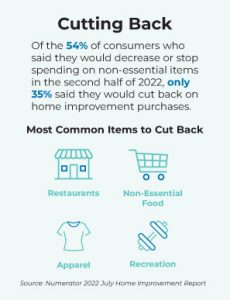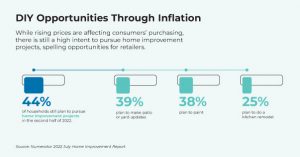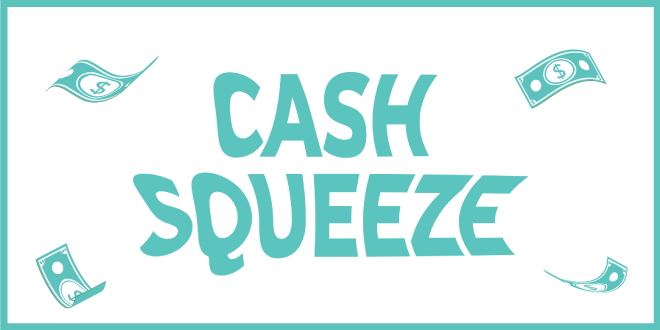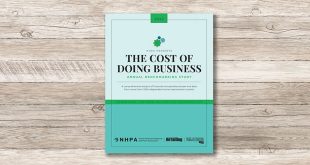If you’re not making price changes today, you may not be in business tomorrow. That’s the stark reality of a market plagued by higher-than-normal inflation and supply chain issues. When cost outruns the shelf price, retailers who fail to keep up may run out of cash, making a solid pricing strategy essential for survival. To learn how retailers are coping with pricing, Hardware Retailing spoke with three retailers who have built strategies that have helped them weather the pricing storm of the past few years. They offer four key components of an effective pricing strategy and a positive price image.
Review Retails Regularly
This year, inflation has caused prices in the home improvement industry to change frequently, sometimes as often as weekly. That’s a shock for an industry where, in the past, retailers may have gotten by with relatively few price changes or low inflation every week. Jeff Pardini, owner of Hills Flat Lumber with two locations in northern California, says making price adjustments isn’t optional if you want to stay in business.
“If you haven’t raised your price and you can’t replace your inventory because your new cost is higher than your retail, then you’re not going to have the money to restock or pay your people or even pay the power bill,” Pardini says.
 With the exception of tariffs, the hardware market has been nearly inflation-free for almost 10 years, but now Pardini says there are at least four to five times more price changes as there were a few years ago. He reviews and updates prices at least once a week. Lately he’s been sending out as many as 800 price changes per week for each of his two stores.
With the exception of tariffs, the hardware market has been nearly inflation-free for almost 10 years, but now Pardini says there are at least four to five times more price changes as there were a few years ago. He reviews and updates prices at least once a week. Lately he’s been sending out as many as 800 price changes per week for each of his two stores.
As both a retailer and a software developer, Brad Green has spent his career thinking about pricing strategy and helping retailers understand the impact even small price adjustments can make to the bottom line. He owns two home improvement stores, West Branch Ace Hardware and Standish Ace Hardware in Michigan, and is the creator of the Margin Master pricing software. He says that many retailers have long struggled with pricing, and the current state of inflation will make matters even worse.
“First, lose the assumption that everything is priced correctly in your store,” he says. “Pricing for most retailers is a mess, and it’s costing them 2% or 3% profit simply because prices are not where they should be. And you can’t make up the profit you’re losing, for example, by cutting more keys; you need to update your retails to a proper price point.”
Matt Meyer owns Meyer Ace Hardware and just added his fifth location in northern Michigan. He made the move to clean up his pricing structure a few years ago, which gave him a better foundation to deal with the avalanche of pricing challenges that started in 2020.
“We hired a consultant to help us rebuild our pricing strategy, top to bottom,” he says. “As part of the process, we installed a pricing software that helped us better control our prices and maximize our margins across the board.”
Once the system was set up, ongoing maintenance was easier, and he’s been able to get his staff into a regular pattern of making price changes. He downloads price changes from his co-op every Monday, gives his staff a couple of days to make the changes on the shelf and then finalizes the changes in his POS system. He says it’s important to keep up with it, because missing even one week can put an extra burden on the staff. Getting prices on the shelf can be where many retailers have trouble.
One of the most common complaints Green hears from other retailers is that they don’t have time to change prices. To compound the issue, it’s hard enough to find enough staff to wait on customers, let alone change the bin tags for a price adjustment. However, not changing the prices is costing you significant profit dollars and can also lead to customer confusion if the price on the shelf doesn’t match the price at the register. If you’re short staffed or can’t get the changes done during regular store hours, you may need to ask employees to stay after for a couple of hours and pay them for the extra time.
“Get creative and make it fun,” Green says. “Maybe buy them pizza or a movie ticket. It’s amazing how many bin tags a handful of people can change in a couple of hours. Not changing those prices is costing you thousands of dollars, so whatever it takes, you have to get it done.”
Review Your Pricing Strategy
Higher cost of goods, higher expenses due to inflation and rising labor costs are just a few of the reasons why, more than ever, retailers need to be savvy about their pricing. If it’s been a while since you reviewed your overall pricing strategy, take the time to analyze every department in your business to make sure you’re maximizing your margins. But don’t use the same pricing strategy for every department.
 “You can’t paint the whole store with the same pricing strategy,” says Meyer. “There are some areas where you want to be more competitive. You have to look at your business department by department. You can often make more margin on lower priced items, like drill bits for example. Make sure you’re also using a rounding strategy that will give your margins an extra boost. Rounding up even by 10 cents on an item can add a lot of money to your bottom line.”
“You can’t paint the whole store with the same pricing strategy,” says Meyer. “There are some areas where you want to be more competitive. You have to look at your business department by department. You can often make more margin on lower priced items, like drill bits for example. Make sure you’re also using a rounding strategy that will give your margins an extra boost. Rounding up even by 10 cents on an item can add a lot of money to your bottom line.”
Make sure you’ve kept up with any changes in the competitive landscape around you, too. Using suggested retail prices is a good start, but you may choose to adjust the prices based on your goals for a particular department. “Too many retailers blindly follow suggested retail price,” Green says. “But there are many unique pricing opportunities and challenges in every market. Implementing an intelligent market-driven pricing strategy will deliver an improved bottom line. Establishing pricing that achieves your desired profit levels is the most important role in a retail operation.”
There may be areas where you need to maintain a thin margin to stay in line with competitors on price-sensitive items. However, there are also many areas where you can improve margins without affecting your pricing image.
“Everyone is looking at prices more, but there are some items where it doesn’t really make a difference,” Pardini says. “If you’re not sure if a particular item is priced right, then ask five different people on your staff what the price should be. If you get five different answers, then it’s a good bet your customers don’t know what the price is either. And if your customers think the price is too much, they’ll let you know. In the meantime, don’t undervalue your business by keeping your prices too low.”
Pardini suggests retailers use a price management software such as Green’s Margin Master to keep up with price changes and identify margin opportunities. Many times, price changes will be incremental and customers may not even notice. When Green and Pardini talk about raising prices, they’re not talking about gouging customers. Rather, they suggest strategically adding even a few pennies or dimes to the price on selected items, which will make a big difference for the business.
“I think pricing is critically important. If retailers had a way to drive another 3% or 4% to their bottom line by something other than pricing management, they would do it,” Green says. “They’ve already squeezed their expenses to the max, and there’s not a lot of other places to turn for margin improvements. But a small 5 cent or 10 cent change in price adds significantly to the bottom line.”
Have a Price-Matching Policy
Even if you’re making weekly price changes and the cost on the shelf is higher than it’s ever been for consumers, it is still important to maintain your competitive price image. Inflation is hitting all home improvement retailers equally and big-box retailers will also be raising their prices to stay profitable. As it has always been, using a price-matching guarantee will be one of the best ways to level the playing field and survive today’s pricing challenges.
 “Many retailers may be fearful of it but it’s important they get past it; hang up a banner in your business that says you’ll match anyone’s price,” says Green. “Home Depot and Lowe’s both do that, and in fact say they’ll beat a competitor’s price by 10%. Don’t be afraid to do that too. If we were to track how many times a customer actually asked to match a price, it’s not very often.”
“Many retailers may be fearful of it but it’s important they get past it; hang up a banner in your business that says you’ll match anyone’s price,” says Green. “Home Depot and Lowe’s both do that, and in fact say they’ll beat a competitor’s price by 10%. Don’t be afraid to do that too. If we were to track how many times a customer actually asked to match a price, it’s not very often.”
When a customer does challenge your price, then match it, even if you make little or no margin, he says. If the customer wants you to match the price on an item that is not the same as what you sell, for example if it’s a different brand or model with different features, then take the time to explain the quality differences between your product and the competitor’s. Put the focus on the quality of the product rather than the price. Even when the price match seems unjustified, don’t send the customer away upset and without the product, because they may never come back. By rejecting their price match request, you will have solidified in that customer’s mind the impression that your prices are too high, especially if they visit a discount retailer and start comparing all of your prices. The cost of losing that one customer, who is sure to tell their friends about their experience, is more than a few dollars lost on a single product.
Instead, says Green, maintain your price image the same way the big boxes do. Price match, but also utilize good merchandising techniques such as endcaps, dump bins and impulse displays. Look for margin opportunities wherever you can but also make sure you are priced right on all of the price-sensitive items. Since you have a price-matching policy, customers will perceive you are priced competitively. The amount of price competitive leverage you can gain with a price-matching policy far outweighs any money you may lose on a single transaction.
Win on Service
Customers want low prices, quality and service. Pardini says most retailers offer a combination of competitive prices, outstanding customer service and quality products, but at the end of the day, one or two of those three will rise to the top as what sets you apart. Hills Flat Lumber has been in business for more than 100 years, and over that time span, he says they’ve tried a variety of tactics to appeal to the customer. They’ve had the most success striking a balance that leans toward service, which usually wins out over price in attracting repeat customers.
“In the past, we’ve tried carrying cheap lumber, and we usually just ended up with unhappy customers and piles of junk lumber we couldn’t sell,” he says. “It doesn’t matter how cheap the price is if the quality is so bad the product is unusable, and if the service level is bad, it doesn’t matter how good the quality or how low the price. We feel we need to be reasonable on the price, but let quality and service lead.”
Customers who find good customer service and a quality product at your business will return. Most will expect to pay a slightly higher price in return for that shopping experience. In the end, a healthy retail strategy should be value-based rather than price-driven.
Pardini continually looks for ways to strengthen the value proposition he offers customers. He encourages retailers to think about what service means to their customers. It might mean extending your business hours or offering convenient parking. You may need to do online sales better than anyone else or offer free delivery. Hill Flat Lumber offers free delivery and installation on the appliances they sell, which is a service others in the market don’t offer. Even during a time of high inflation, value will still make a difference when customers choose where they will shop.
“When a customer pulls out of their driveway and heads for the hardware store, they’ve already made up their mind where they are going,” says Green. “They could turn one way and go to the big-box or turn the other and go to your store. They’re coming to the independent retailer, maybe expecting to pay a premium price, but they are also expecting you to call them by name, ask about their kids and ask them how you can help them. That’s why they‘re coming to you. If they were only looking for the cheapest price, they could order it on Amazon and have it tomorrow.”
 Hardware Retailing The Industry's Source for Insights and Information
Hardware Retailing The Industry's Source for Insights and Information








